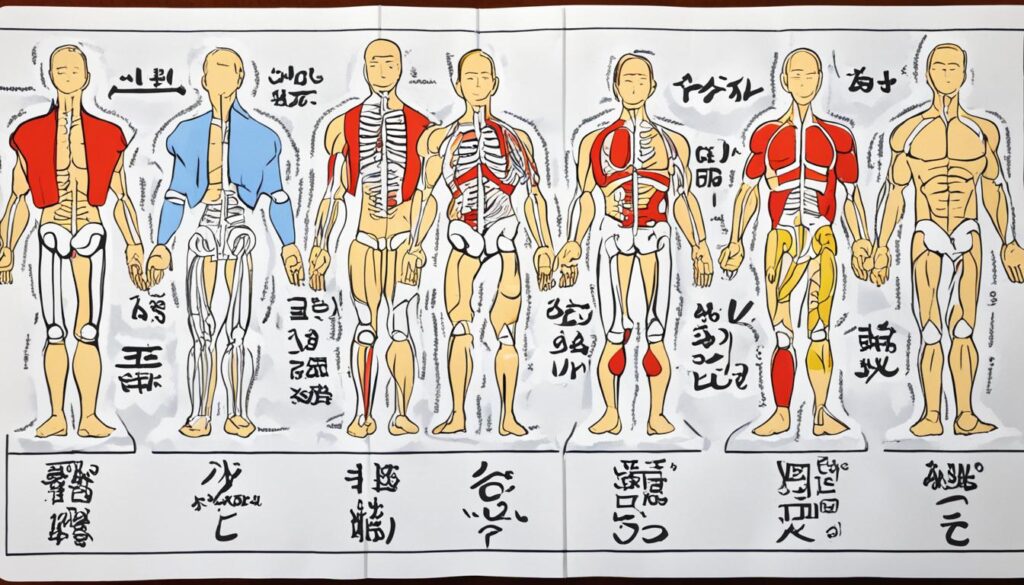
Welcome to our guide on how to say body parts in Japanese! In this article, we will provide you with a comprehensive list of body parts vocabulary and their corresponding Japanese names. By learning these words, you will be able to expand your Japanese language skills and enhance your communication abilities.
Whether you are a beginner or have some knowledge of the Japanese language, understanding how to describe body parts is essential for everyday communication. By familiarizing yourself with these words, you will be able to accurately describe various body parts in Japanese and engage in more detailed conversations.
If you’re ready to enhance your language skills and learn how to say body parts in Japanese, let’s get started!
Common Body Parts Words in Japanese
Learning body parts in Japanese is crucial for effective communication. In this section, we will explore the most common body parts words in Japanese. By mastering these words, you will be able to accurately describe various body parts in everyday conversations.
Here are some essential body parts words you need to know:
| English | Japanese |
|---|---|
| Head | 頭 (あたま / atama) |
| Hair | 髪の毛 (かみのけ / kaminoke) |
| Eyes | 目 (め / me) |
| Nose | 鼻 (はな / hana) |
| Ears | 耳 (みみ / mimi) |
| Mouth | 口 (くち / kuchi) |
| Neck | 首 (くび / kubi) |
| Shoulders | 肩 (かた / kata) |
Remember to practice pronunciation and use these words in context to solidify your understanding. Now, let’s move on to the next section and explore how to describe body parts in Japanese.
Describing Body Parts in Japanese
In this section, we will provide you with a simple and effective way to describe body parts in Japanese. The ability to express oneself accurately regarding body parts is essential for effective communication in any language. Learning the proper terminology for body parts in Japanese will enable you to have meaningful conversations and engage in various interactions.
Native Japanese speakers often use a sentence pattern that follows the structure “Topic は Noun が Adjective です” to describe someone’s body parts in a natural and conversational way. By understanding and utilizing this pattern, you will be able to confidently describe different body parts in Japanese.
For example, to describe someone’s beautiful eyes, you can use the sentence structure:
“あの人の目はきれい(な)です” (Ano hito no me wa kirei(na) desu), where “あの人の目” (Ano hito no me) means “that person’s eyes,” “きれい(な)” (kirei(na)) means “beautiful,” and “です” (desu) is a copula used to indicate a state or attribute.
By applying this sentence pattern, you can describe various attributes of body parts, such as size, shape, color, and condition. This will allow you to express yourself accurately and provide precise descriptions in Japanese when discussing body parts.
Example Sentences:
| English | Japanese |
|---|---|
| His hair is long. | 彼の髪(かみ)は長(なが)いです。(Kare no kami wa nagai desu.) |
| Her nose is cute. | 彼女(かのじょ)の鼻(はな)はかわいいです。(Kanojo no hana wa kawaii desu.) |
| The baby’s hands are small. | 赤(あか)ちゃんの手(て)は小(ちい)さいです。(Akachan no te wa chiisai desu.) |
Remember to practice using this sentence pattern in a variety of contexts to improve your fluency in describing body parts in Japanese. With time and practice, you will become more comfortable and confident in expressing yourself accurately and naturally.
Body Parts of the Head in Japanese
In this section, we will explore the body parts of the head and their corresponding Japanese names. By learning these words, you will be able to enhance your vocabulary and engage in more detailed conversations about the different parts of the head in Japanese.
Here are some essential body parts of the head in Japanese:
| English | Japanese |
|---|---|
| Head | 頭 (あたま) |
| Eyes | 目 (め) |
| Ears | 耳 (みみ) |
| Nose | 鼻 (はな) |
| Mouth | 口 (くち) |
| Face | 顔 (かお) |
| Hair | 髪 (かみ) |
Learning these words will allow you to accurately describe and discuss the different parts of the head in Japanese. With a solid understanding of head body parts vocabulary, you will be able to have more meaningful interactions and express yourself fluently in Japanese.
By visualizing the head body parts in the image above, you can further reinforce your learning and improve your ability to identify and name these body parts in Japanese.
General Body Parts Vocabulary in Japanese

Expanding your Japanese language skills involves learning vocabulary related to different body parts. In this section, we will introduce you to a comprehensive list of general body parts vocabulary in Japanese. Familiarize yourself with these words to enhance your ability to communicate effectively about various body parts in Japanese.
Here are some essential body parts words in Japanese:
| English | Japanese |
|---|---|
| Shoulder | 肩 (かた / kata) |
| Arm | 腕 (うで / ude) |
| Hand | 手 (て / te) |
| Leg | 脚 (あし / ashi) |
| Foot | 足 (あし / ashi) |
| Chest | 胸 (むね / mune) |
| Back | 背中 (せなか / senaka) |
Use these words to describe and discuss different body parts accurately in Japanese conversations. Practice using them in sentences and engage in meaningful exchanges about physical attributes.
Additional Body Parts Vocabulary in Japanese
Expand your Japanese body parts vocabulary even further with additional words for various body parts. By learning these new terms, you will have a wider range of vocabulary to accurately describe and discuss different parts of the body in Japanese.
Here are some important body parts words to add to your Japanese language repertoire:
- Elbow – ひじ (Hiji)
- Wrist – てくび (Tekubi)
- Thigh – もも (Momo)
- Knee – ひざ (Hiza)
- Ankle – くるぶし (Kurubushi)
- Toe – つまさき (Tsumasaki)
- And more…
By familiarizing yourself with these additional body parts words in Japanese, you will be able to express yourself more accurately and fluently when discussing and describing various parts of the body. Practice using these new words in sentences to reinforce your understanding and improve your Japanese language skills.
